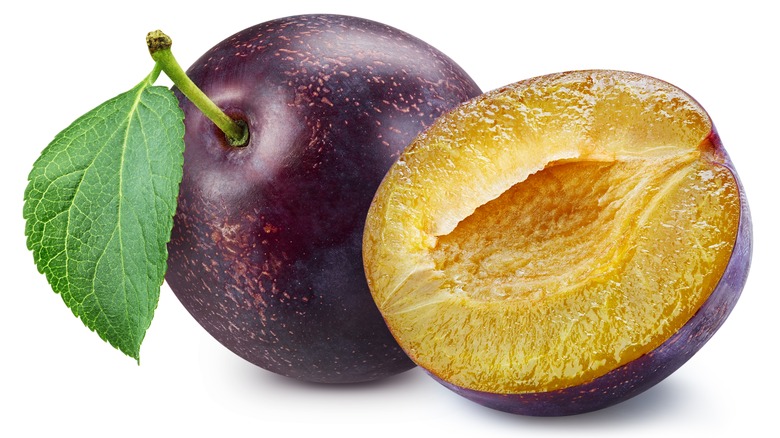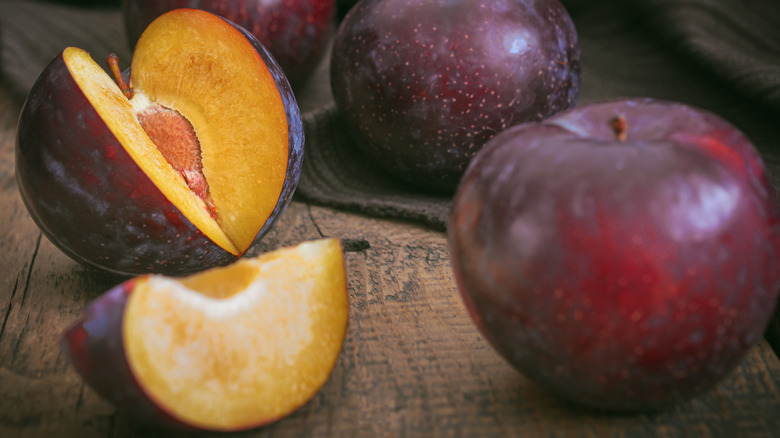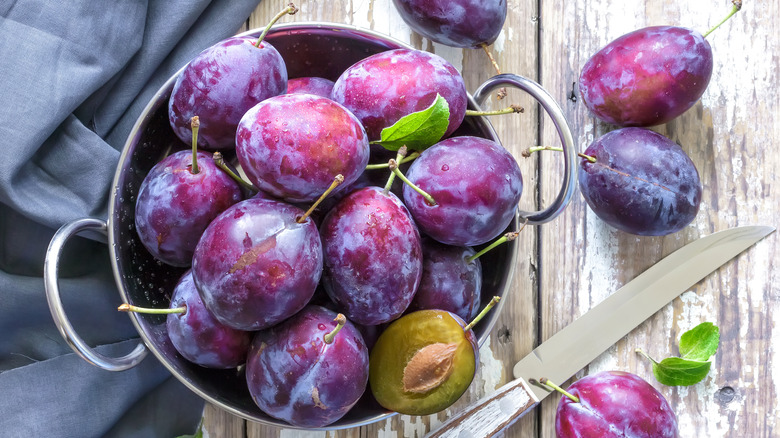Here's Exactly What To Look For When Buying A Plum
Sweet and luscious, plums are close cousins of fellow summer fruits like apricots, peaches, and nectarines. They've been around for a long time: They were first grown in China around 470 B.C., then brought to Japan and some regions of Europe. The pilgrims brought European plums to America in the 17th century, where they interestingly became a part of Christmas culture in the 1800s, highlighted by a mention of Clement C. Moore's 1823 poem, "A Visit from Saint Nicholas," and even in Tchaikovsky's "Dance of the Sugar Plum Fairy".
Boasting antioxidants, vitamins, minerals, and fibers that promote weight management and heart health, per an article in the Journal of Food, Nutrition and Population Health, versatile plums can be enjoyed fresh, dried, or cooked into everything from a fresh plum crumble recipe to lamb biryani. These recipes turn out beautifully when the fruit is perfectly ripe, but sometimes, it can be hard to know when that is — because plums come in as many as 2,000 varieties, with colors ranging from bright yellow to deep red, purple, and blue. Here's how to know which plum is ready for eating and cooking.
Check the appearance
Choosing the best fresh plums can take a bit of trial and error. The first step is to check the color, firmness, and smell of the fruit. Steer clear of the green (unripe) ones and instead pick plump, evenly colored, blemish-less, and wrinkle-free fruits. You also want to avoid plums that have shriveled, as well as those with broken skins, mushy spots, and any indentations or wounds they may have gotten while packed together with the stems. While these imperfections aren't necessarily unsafe, they may mean the fruit has gone past its peak of deliciousness. Of course, mold is a sign that you should discard the fruit.
When you hold a plum in your palm, it should feel heavy and give slightly when poked, Does It Go Bad advises. This is because fresh plums have a high water content. "If it feels light, the water has started to evaporate, and the plum may not be fresh," Treehugger explains. Discard the ones that feels squishy and ooze juices, because they are either overripe or have gone bad. Finally, you can also tell if a plum is good by inspecting the inside. Make sure the flesh is not mushy or browning and is free of insects, worms, larvae, and eggs.
Give it a smell and taste test
A ripe plum usually has a fresh, sweet, and fruity fragrance, while an unripe one will have a very faint aroma, if at all. The better the fragrance, the better the fruit, but bear in mind that some varieties have stronger fragrances, and so the key here is to pick the sweetest smelling ones. When bitten into, a ripe plum should be sweet with a hint of tartness, while an unripe one may be crunchy and lack sweetness.
Finally, remember that plums continue to ripen after they have been picked, and if you happen to have a few green ones, it is best to store them at room temperature on the counter in a paper bag for two to three days to let them ripen by themselves, advises Gardenality. However, ripe plums are easily perishable when stored at room temperature and must be consumed within a few days of bringing them home. It's also wise to store them away from other fruits to avoid bruising. Alternatively, you can place them in the crisper of your fridge and use them within a week or two, or freeze them until a recipe calls for them.


